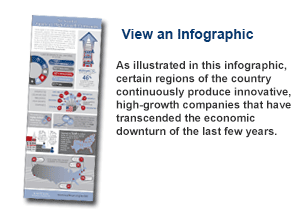In the entrepreneurship and economic development realms, the word “high-growth” is tossed about loosely, often used to define that rare, illusive, overnight success of a startup. The companies desperately sought out by regional and state economic development programs are those founded by some technologically gifted youth that today employ thousands. But a recent study by Kauffman has proved that high-growth firms aren’t as hard-pressed to find as we thought … so long as you’re looking in the right places. And by not looking in the right places, economic development programs designed to help these firms grow even faster might be missing 75 percent of high-growth companies.
To find out the geographical and industrial makeup of these job creation powerhouses, Dane Stangler, director of Research and Policy at the Kauffman Foundation, and his team, examined geographic trends of firms included in the 1982 to 2010 Inc. 500 lists, to analyze how regional characteristics are associated with high-achieving companies and innovation. The findings in “The Ascent of America’s High-Growth Companies” are pretty intense.
Simply put, high-growth firms can live anywhere and high-growth and high-tech are not synonymous.
Dane elaborated on these findings in a recent press release, saying, “Our analysis of these fast-growing firms shows us that high-growth company founders can come from anywhere. Their firms can be found throughout the country and, rather than following the conventional expectation that high-growth companies are grouped into a narrow technology category, they represent exceptionally diverse industry segments. These findings offer important lessons for economic development leaders, such as to target firms that are high-growth rather than high-tech.”
Of course, the usual suspects when it comes to location were high on the list, with Silicon Valley, Austin, and other traditional high-tech hotbeds well-represented among the cities that house high-growth companies. But the research also showed that cities like Salt Lake City, Indianapolis, Buffalo, and several other Rust Belt icons also have accumulated a significant cache of Inc. 500 firms.
Clearly, the first way to encourage entrepreneurial activities in your community is to believe they can occur there and are not the exclusive good fortune to a select few regions.
